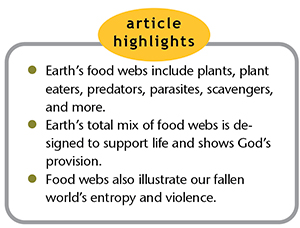 Real-world ecology supports the Bible’s trustworthiness. Accordingly, how creatures get and use food matches how Scripture describes our world.1-3
Real-world ecology supports the Bible’s trustworthiness. Accordingly, how creatures get and use food matches how Scripture describes our world.1-3
Food energy is one of life’s basics; all living things need metabolic energy from some kind of food.1,4 God has fitted diverse creatures—living in this fallen world—for food webs so they can fill Earth’s habitats. These food webs display God’s caring providence. However, food webs “groan” with biochemical entropy in serial energy transfers that progressively lose usable energy, demonstrating creation’s fallenness.2,3,5
Food Energy Transfers Exhibit God’s Good Providence
The notion of a food chain (or food pyramid) is a simplified concept for understanding food energy transfers. Photosynthetic plants are autotrophs—they produce their own food energy from sunlight and inorganic resources like carbon dioxide and water. Plants also become food for heterotrophs (life forms that consume other life forms as food).4
Food chains start with plant material (seeds, fruits, leaves, nuts, grains, grasses, root vegetables) eaten by herbivores like marmots, moose, moths, manatees, or monarchs. Herbivores are eaten as prey by carnivores or omnivores like walruses, wolves, weasels, wrasses, or wolverines. Some predators prey on other predators, so food chains may include secondary, tertiary, and quaternary consumers—with apex predators at the top of the food chain.5 However, apex predators themselves become food for parasites like blood-sucking ticks or mosquitoes. Apex predators eventually die; their corpses are eaten by scavengers like vultures. Thereafter, carrion leftovers are further consumed by detritivores like earthworms and decomposers like fungi.4
In sum, food energy is recycled as food chains branch out into what are really food webs—and those webs are further expanded by nitrogen cycle branching (including nitrogen-fixing bacteria) that extends beyond webs of carbohydrate trophic transfers, food chain processes that metabolically harness carbohydrate food energy.6
Food Energy Transfers Exhibit Creation’s Wasting Fallenness
Yet, at each trophic level (each “link” of a food chain) as food energy transfers from producer to consumer and then onto the next consumer, etc., the quantity of biochemically usable energy is wasted, lost, or depleted, with heat emitted as wasted energy.2,3,5,6 This waste exhibits the Second Law of Thermodynamics, i.e., entropy, a universal rule.3
Thus, the repeated loss of useful energy in serial transfers of energy via the food chain illustrates Earth’s fallen ecology, corroborating Scripture’s description of creation as “groaning.”2,3
In summary, food energy transfers—everywhere and every day—corroborate what the Bible teaches about God’s careful and caring providence: God fits creatures to fill our fallen world.
References
- Acts 14:15-17. See also 1 Timothy 4:1-5; 1 Corinthians 10:31; Deuteronomy 8:3; Matthew 4:4. As food energy transfers from one life form into another, we see God’s providence in action. See Johnson, J. J. S. 2011. Our Daily Bread: How Food Proves God’s Providence. Acts & Facts. 40 (4): 8-9.
- Romans 8:19-22. Because nature is fallen—due to Adam’s sin in Eden—we see how food energy transfers are thermodynamically inefficient and wasteful. See Johnson, J. J. S. 2010. Misreading Earth’s Groanings: Why Evolutionists and Intelligent Design Proponents Fail Ecology 101. Acts & Facts. 39 (8): 8-9. God Himself is not “prodigal”; rather, creation now experiences wastefulness (entropy) as the Edenic curse applies to life forms. See Johnson, J. J. S. 2019. Green Bean Bioengineering Shows Creator’s Care. Acts & Facts. 48 (10): 21.
- Morris, H. M. Death and Spilled Water. Days of Praise, October 2, 1996.
- God fitted diverse plants for delivering food energy to animals and humans directly (when plants are eaten) and indirectly (when planteaters are eaten or by the consuming of consumers). “Thus each ecosystem is regularly renewed through the process of [food energy] production and consumption. The consumers are animals and other organisms [such as fungi]...[that] obtain energy from the chemical compounds they consume....Microbes on the forest floor decompose the discarded material that falls within their reach. Parasites feed on living hosts, weakening them and helping to control their populations. Scavengers, such as vultures, feed on carrion and partially decayed material. Herbivores—such as rabbits, deer, and a variety of birds, and many destructive forest insects—consume vegetation. Carnivores eat other consumers, and omnivores can eat almost anything.” Sutton, A. and M. Sutton. 1986. Eastern Forests. New York: Alfred A. Knopf, 29.
- “However, by the time the top of the pyramid has been reached, little useful energy is left and only 1/20 of an ounce of fish tissue has been produced [from the original pound of biomass produced by the autotrophic algae]....The reason is that, in the move from one trophic level to the next, most of the useful living material is converted into heat energy, which is not useful [food] energy.” Niering, W. A. 1998. Wetlands. New York: Alfred A. Knopf, 132.
- Nutritious nitrates can be transmitted from place to place by slow-motion insect couriers, such as the prairie’s dung beetle. See Johnson, J. J. S. 2017. Dung Beetles: Promoters of Prairie Preservation. Acts & Facts. 46 (1): 21.
* Dr. Johnson is Associate Professor of Apologetics and Chief Academic Officer at the Institute for Creation Research.










